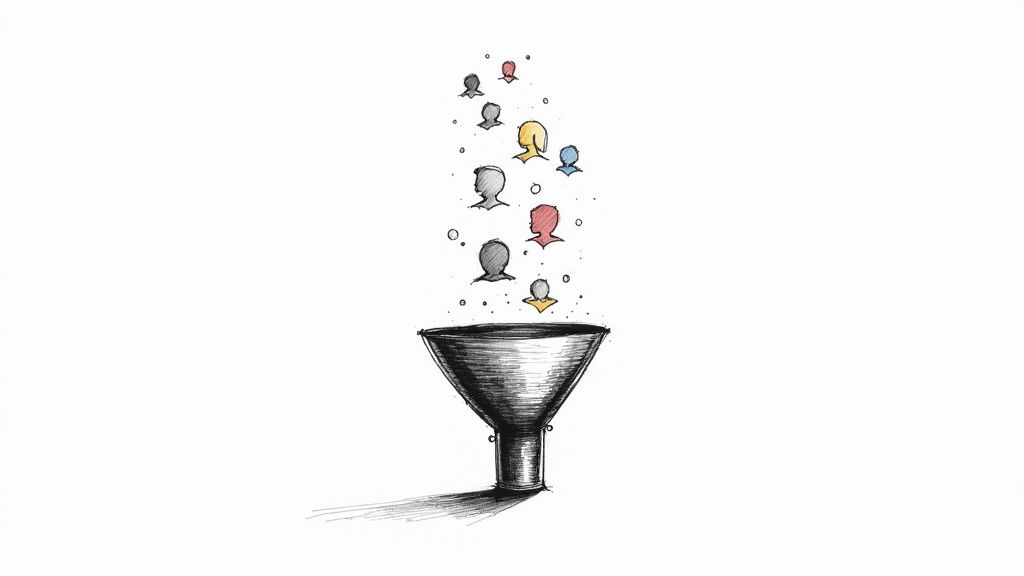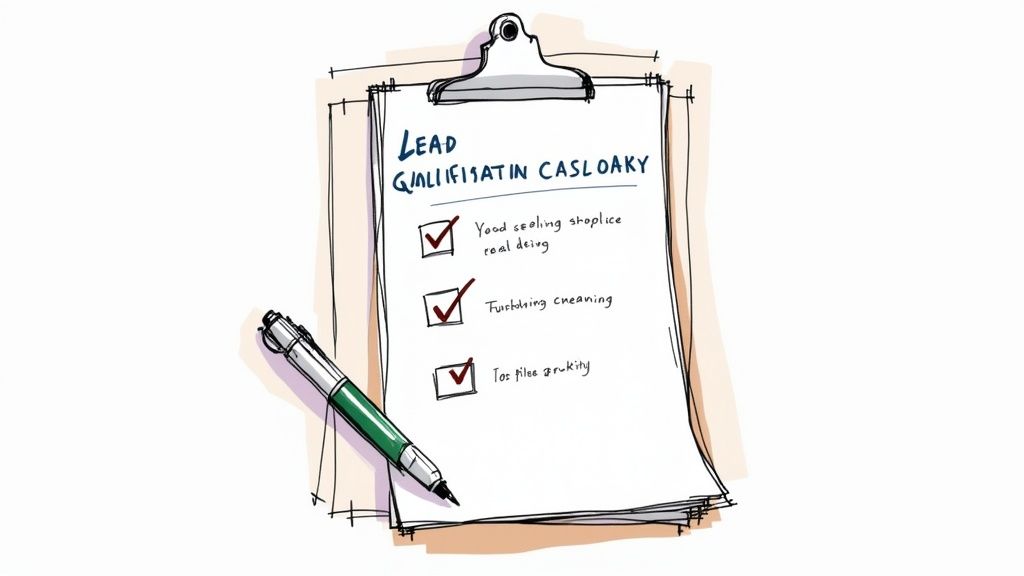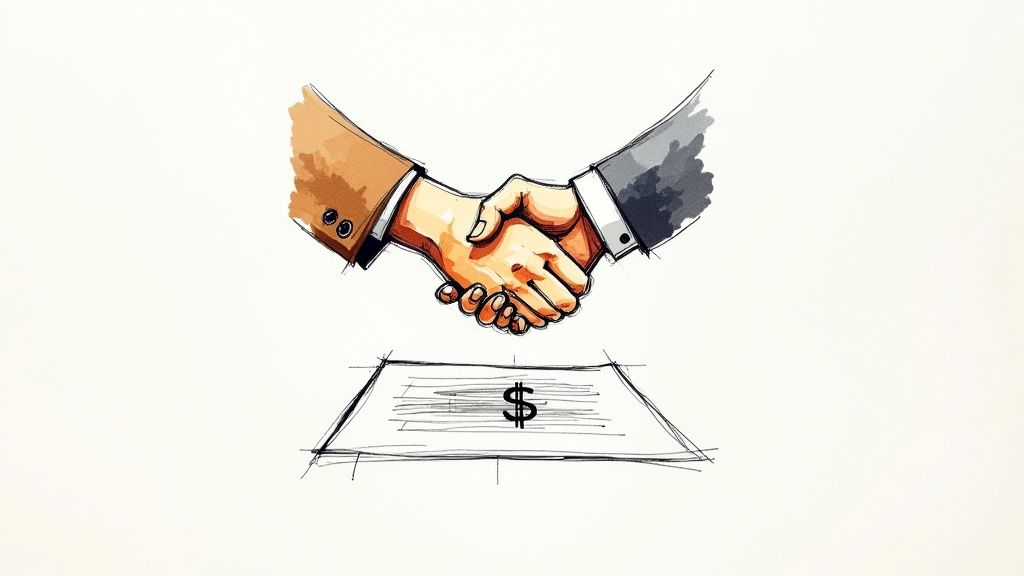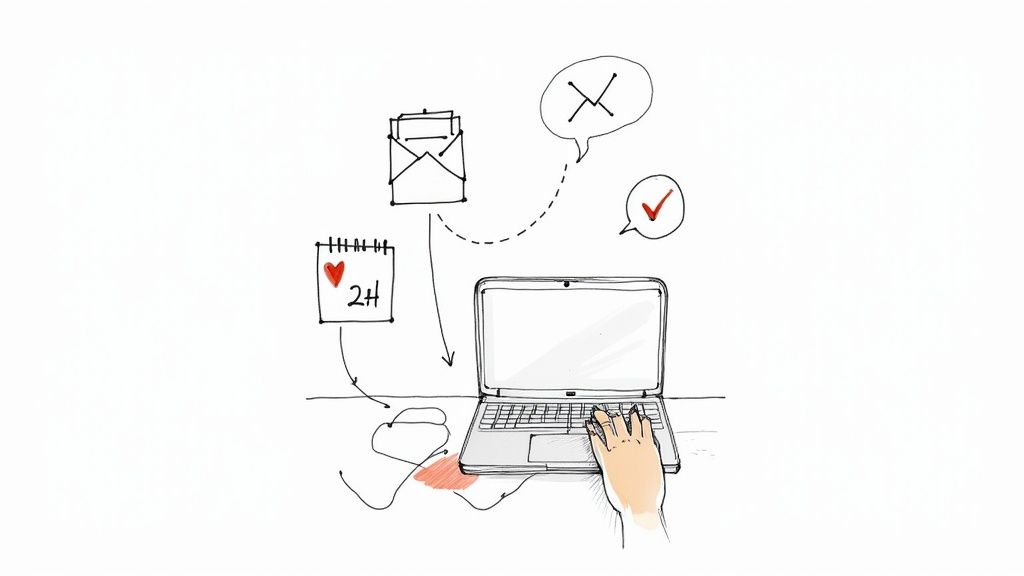Ready to build a sales pipeline that actually works? Forget the rigid, one-size-fits-all templates. A high-performing pipeline is all about mapping out your customer's buying journey, not just your team's selling process.
Think of it as your strategic blueprint. It's a living, breathing framework that shows you exactly where every single deal is and what needs to happen to push it over the finish line. This is how top-performing teams build a predictable, repeatable flow of new business.
From a Flood of Leads to Real Opportunities
The core idea is simple: turn a large volume of initial interest into a manageable number of real, closable deals. Not every lead will be a perfect fit, and that’s okay. In fact, that's the point. A strong pipeline is built on its ability to filter and qualify effectively.
Having a well-defined process creates predictability. It’s not just a nice-to-have; it’s a competitive advantage. A study by the Harvard Business Review found an 18% difference in revenue growth between companies with a formal sales process and those without one. This structure takes the guesswork out of the equation and ensures no valuable lead falls through the cracks.
A sales pipeline is a visual snapshot of where prospects are in the sales process. It shows you how many deals salespeople are expected to close in a given week, month or year and how close a rep is to reaching their sales quota.
This process visualizes how a large number of leads gets distilled down into qualified opportunities.

The big takeaway here is the natural drop-off at each stage. It's a numbers game that highlights just how critical both high-volume prospecting and effective qualification really are.
Mapping Your Core Sales Pipeline Stages
While every business has its own unique quirks, most successful sales pipelines are built on a similar foundation. The secret sauce is defining your stages based on the buyer's actions, not just your team's activities. It’s a subtle shift, but it makes your forecasting infinitely more accurate.
Use this table as a starting point to map out the core stages of your pipeline. Define what each stage means, what the primary goal is, and what action needs to happen to move a deal forward.
This framework isn't set in stone. The goal is to create a clear, logical path that reflects how your customers buy. Tailor these stages, add your own, and make it fit your specific sales motion.
This is the foundational step toward building a predictable revenue engine for your business. Once you have these stages defined, you can start filling them up and optimizing the flow.
Filling Your Pipeline with the Right Opportunities

An empty pipeline is every sales team's worst nightmare. But you know what's just as bad? A pipeline stuffed with junk leads. It's a surefire way to waste time, kill morale, and create a totally false sense of security.
So, the very first step in building a healthy sales pipeline is to commit to quality over quantity. This all starts with knowing exactly who you're selling to.
And I mean getting way beyond basic details like company size or industry. A truly powerful Ideal Customer Profile (ICP) dives into the real-world stuff—the challenges, goals, and buying triggers of your absolute best customers. Who feels the pain your solution solves most? What's happening in their world that makes them start looking for a new way of doing things?
Nailing down these answers transforms your prospecting from a shot in the dark into a targeted mission. You're no longer just looking for any company; you're hunting for specific signals that tell you there's a real need and genuine interest.
Crafting a Multi-Channel Prospecting Strategy
Once you have a crystal-clear ICP, it's time to build a prospecting engine that consistently uncovers these high-potential accounts. Don't make the mistake of relying on a single channel. The most resilient pipelines I've seen are always filled using a smart blend of outbound and inbound tactics.
Think about how a B2B SaaS company might do this. They could find their best leads through a mix of approaches:
- Hyper-Personalized Outbound: A sales rep spots a company that just hired a new VP of Operations—a key buying signal from their ICP. That rep sends a personalized LinkedIn message that references the new role and explains how their software helps new leaders make a quick impact.
- High-Value Inbound: The marketing team publishes a detailed guide on "Improving Operational Efficiency for Mid-Sized Manufacturers." This piece of content naturally attracts prospects who are already actively researching the exact problems the software solves.
This two-pronged approach ensures a steady flow of opportunities. While your outbound efforts are actively hunting for perfect fits, your inbound marketing acts like a magnet, pulling in qualified prospects who are already problem-aware. For a much deeper dive, our guide on how to generate more leads gives you some actionable frameworks you can use right away.
Balancing Volume and Quality
The real goal here is to generate a predictable stream of opportunities. This requires a systematic approach to prospecting that you can measure and tweak over time. You have to find that sweet spot between getting enough volume at the top of the funnel and ensuring those leads are high-quality and aligned with your ICP.
A classic mistake is chasing raw numbers and forgetting about lead quality. A pipeline filled with 100 unqualified leads is far less valuable than one with 10 highly qualified opportunities that perfectly match your ICP.
To keep your pipeline consistently strong, you'll need to explore different effective lead generation strategies and find the right mix for your market. Always be analyzing which channels bring in the deals that close the fastest and have the highest lifetime value. This data-driven approach lets you double down on what's working, making sure your pipeline is always stocked with opportunities that are truly worth pursuing.
Mastering Lead Qualification and Nurturing
 Let's be honest: not every lead that lands in your pipeline is a winner. The real secret to building a high-performing sales pipeline is knowing exactly where to focus your team's energy. This comes down to mastering lead qualification—the critical process of sorting the window shoppers from the serious buyers.
Let's be honest: not every lead that lands in your pipeline is a winner. The real secret to building a high-performing sales pipeline is knowing exactly where to focus your team's energy. This comes down to mastering lead qualification—the critical process of sorting the window shoppers from the serious buyers.
If you skip this step, your reps will burn hours chasing deals that were doomed from the start. That’s a fast track to missed quotas and plummeting team morale. The solution is to create a consistent, repeatable framework for sizing up every single lead.
Adopting a Qualification Framework
One of the most battle-tested frameworks out there is BANT. It’s been around forever for a reason—it’s simple, effective, and gives your discovery calls a clear structure. BANT stands for:
- Budget: Does this prospect actually have the money to buy what you’re selling?
- Authority: Are you talking to the person who signs the checks, or someone who can get you to them?
- Need: Is there a real, painful problem that your solution solves for them?
- Timeline: Are they looking to make a move now, or is this just a "maybe someday" idea?
BANT is a fantastic starting point, but don't treat it like gospel. The real goal is to customize it. You need to define what a "perfect fit" customer actually looks like for your business. This systematic approach is how you build a predictable sales engine. For those looking to put this on autopilot, our guide on automated lead qualification dives into more advanced tactics.
A lead isn't "qualified" just because they downloaded an eBook. True qualification happens when there's a confirmed need and a clear path to a potential sale. It's about conversation and confirmation, not just contact information.
The Art of Nurturing High-Potential Leads
So, what do you do with a lead who has a genuine need but the timing is all wrong? You don't just toss them aside. You nurture them. Nurturing is all about staying top-of-mind and building trust with prospects who aren't ready to pull the trigger today.
This isn’t about spamming them with generic "just checking in" emails. Effective nurturing is about providing consistent, targeted value.
For instance, if a prospect says their budget doesn't free up for another six months, mark your calendar. In the meantime, send them a case study from a similar company or invite them to a webinar that hits on their specific pain points. You stay relevant, you stay helpful, and you position yourself as the go-to expert when they are ready to buy.
The health of your pipeline depends on keeping a close eye on these activities. Tracking daily metrics like the number of Sales Qualified Leads (SQLs) added and follow-ups made is crucial for keeping momentum. In fact, research shows that responding to a lead within an hour can boost your conversion success by up to sevenfold. It's proof that consistent, timely engagement is what turns potential into profit. To get a better handle on this, you can learn more about critical sales pipeline metrics on forecastio.ai.
Using Technology to Automate and Scale Your Pipeline
https://www.youtube.com/embed/z_Uhgqk9E9I
Let's be honest. Relying on spreadsheets and manual tracking to run your sales pipeline is a recipe for missed opportunities and chaos. To build a sales process that actually scales, technology isn't just a nice-to-have; it's the engine that drives all your momentum.
Without it, you're essentially flying blind, depending on memory and sticky notes while your competitors are using data to run circles around you.
A well-configured CRM should be the central nervous system of your sales world. It's the single source of truth that tracks every call, email, and interaction, giving you a complete, real-time picture of where every single deal stands. This gets rid of the guesswork and makes sure your entire team is working from the same playbook.
Choosing the Right Sales Stack
Your technology stack should do more than just store information—it needs to actively help you sell. The real goal is to automate the repetitive, mind-numbing tasks that drain your team's energy. This frees them up to focus on what humans do best: building relationships and closing deals.
This is where a platform like PlusVibe becomes so valuable. While it's designed to manage and optimize outreach, its core principles apply to any tool you choose. You want software that handles the low-value work, like logging calls or sending standardized follow-up reminders. If you're looking for ideas on what you can automate, checking out some workflow automation examples can really open your eyes to what’s possible.
The real purpose of sales tech isn't just to make things faster. It's to create a scalable, data-driven system that empowers your team to have more meaningful conversations with the right prospects at the right time.
The right combination of tools can transform pipeline management from a daily chore into a massive strategic advantage, freeing up precious hours every single week.
The Impact of Sales Automation
The massive shift toward digital engagement has fundamentally changed how pipelines are built and managed. Sales automation is no longer a luxury for big enterprises; it's a critical component for any team that wants to grow without burning out.
For instance, this screenshot shows how different AI-driven tools fit into the sales process, covering everything from lead generation to closing the deal.
It's a great visual that proves a modern sales stack isn't about finding one magic bullet. It’s about integrating multiple specialized tools to cover every stage of your pipeline.
This move toward automation pays off, big time. Recent data shows that sales teams using automation can save an average of 5 hours per week on repetitive tasks. And the trend is only accelerating. By 2025, it’s projected that digital channels will handle 80% of all B2B sales interactions, which shows just how urgent it is to adapt.
Beyond time savings, automation also leads to a 20% reduction in human error and can boost ROI by 10-20% for companies that implement AI correctly. You can dig into more stats on this over at kixie.com.
Ultimately, integrating the right tech helps you build a more predictable, powerful, and profitable sales pipeline. If you're ready to get started, you might find our deep dive on how to automate sales process a useful, step-by-step guide.
Optimizing Pipeline Performance with Data and AI

Building a sales pipeline is one thing. Keeping it from breaking is another. Too many teams treat their pipeline like a "set it and forget it" asset, but it’s really a living system that needs constant attention. If you want to turn it into a predictable revenue engine, you have to get your hands dirty with the data.
It’s time to move beyond gut feelings and dig into the hard numbers. Your CRM is a goldmine of insights just waiting to be uncovered. By regularly tracking the right metrics, you can stop guessing and start forecasting with real confidence.
Identifying Your Core Pipeline Metrics
So, where do you start? Don't get overwhelmed by a sea of data. Just focus on a few key performance indicators (KPIs) that give you a clear snapshot of your pipeline's health. You want the numbers that directly tie to revenue and efficiency, not just vanity metrics.
Here are the essentials every sales leader should be watching:
- Stage-by-Stage Conversion Rate: This is huge. What percentage of your deals actually move from one stage to the next? This is how you spot bottlenecks. If you see a massive drop-off between "Demo" and "Proposal," it's a red flag that your demos aren't hitting the mark.
- Sales Velocity: How fast are deals moving from first contact to closed-won? This tells you the average time it takes to close a deal. If your sales velocity is slowing down, there's friction somewhere in your process that you need to find and fix.
- Average Deal Size: What's the typical value of a deal you win? Tracking this helps you forecast revenue more accurately and tells you if your team is spending its time on the right, high-value opportunities.
The proof is in the numbers. Companies that master a few of these core pipeline practices see 28% higher revenue growth. It isn't magic; it's just a commitment to using data to make smarter decisions.
If you want to see how these metrics and stages look in the real world, checking out a detailed sales pipeline sample can give you a tangible blueprint to follow. https://www.plusvibe.ai/blog/sales-pipeline-sample
The Rise of AI in Sales Optimization
Tracking these core metrics is fundamental, but modern tech lets you go so much deeper. Artificial intelligence isn't some futuristic idea anymore—it's a practical tool that's changing how sales teams operate, right now. AI can chew through massive datasets to spot patterns and predict outcomes with scary accuracy.
For instance, AI-powered tools can handle predictive lead scoring by analyzing your historical data to instantly rank new leads by their likelihood to close. This is a game-changer. It lets your team zero in on the most promising opportunities instead of wasting time on leads that were never going to convert.
The impact is impossible to ignore. The global AI market in sales has skyrocketed, jumping from a $1.4 billion valuation in 2020 to a projected $6.4 billion by 2025. This explosion shows just how fast companies are adopting AI to get a competitive edge.
When you pair solid data analysis with smart, AI-driven insights, you can allocate your resources more effectively, patch up weaknesses before they sink you, and turn your sales pipeline into a consistent, high-performing machine.
Got Sales Pipeline Questions? We've Got Answers
Even with the best framework in place, real-world questions always pop up once you start building and managing your sales pipeline. Let's tackle some of the most common hurdles teams run into with some straightforward, experience-based advice.
How Often Should I Review My Pipeline?
For most sales teams I've worked with, a weekly pipeline review hits the sweet spot. But this meeting has to be more than just a status update where reps rattle off their numbers. That's a waste of everyone's time.
Think of it as a strategic huddle. The real goal is to get everyone's eyes on stalled deals, brainstorm creative ways to push tough accounts forward, and make sure enough qualified opportunities are coming in to hit your future targets. A proactive weekly check-in is what keeps the whole system healthy and moving.
The single biggest mistake I see is teams building pipeline stages around what the seller does (e.g., 'Sent Proposal') instead of what the buyer commits to. Strong stages reflect a tangible step the buyer has taken, like agreeing to a demo or giving you access to the real decision-makers.
Shifting your focus this way makes your forecast infinitely more accurate because it aligns your process with the customer's actual buying journey. Getting this right is a huge part of learning how to increase sales conversion rates.
Can I Use One Pipeline for Different Products?
The classic "it depends" answer applies here. A single pipeline can work just fine if your products or services have a pretty similar sales process.
However, you should absolutely create separate pipelines if your offerings have:
- Drastically different sales cycle lengths: A product that closes in two weeks shouldn't be in the same pipeline as one that takes six months. The pacing is completely different.
- Unique customer profiles (ICPs): Selling to enterprise clients is a whole other ballgame compared to selling to small businesses.
- Big gaps in price: A high-ticket item naturally requires more stages, more approvals, and deeper nurturing than a low-cost, quick-win product.
Running separate pipelines for distinct products gives you much cleaner data. You get a clearer picture of what’s working (and what's not) for each specific product line, allowing you to fine-tune each process for much better results.
Ready to build and manage your sales pipeline with precision and stop guessing? PlusVibe uses AI to automate your outreach and makes sure your messages actually land in the primary inbox. This frees your team up to do what they do best: closing deals. Scale your outreach with PlusVibe today!














































.jpeg)


.png)























































